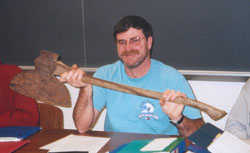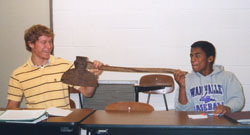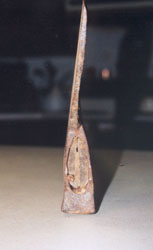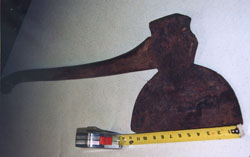
Home
- Artifacts
- Buildings & Businesses
- Churches
- Holidays & Celebrations
- Counties/Locations
- Delta College
- Early Settlers
- Ethnic Background
- Local, Michigan, U.S. and World Events
- Family Genealogy
- Farming
- Libraries & Museums
- Local Sites
- Logging
- Musicians, Artists & Famous People
- Nature, Weather & Four Seasons
- Railroads
- Schools
- Sports
The Ax In The Attic
 |
A hewing ax that has been passed down through three generations of my family sits in mom's attic, awaiting a visit from me, the fourth generation. After visiting the Cushway Home, the oldest home in Saginaw County, and seeing the hewed beams that the house sits on, I decided to look for the ax. Pulling down the steps that go to the attic, I begin the climb. Upon entering the attic I can't believe how much junk is stored up here. After moving about twenty five rolls of Christmas and birthday wrapping paper of various themes, all covered by an undisturbed layer of dust, there is a stack of flimsy boxes containing photo albums and old newspaper articles. Under the boxes lies a musty old blanket, and picking it up, I find an old saw that was used as a companion to the ax. The saw was used to make the relief cuts in the logs before the ax would be used. Finally, I see the object of my desire, the old hewing ax.
 |
The ax dates back to at least 1898, when the farm of Joseph Darga, my great grandfather, was established in Posen, Michigan. He was a lumberman and owned huge sections of land. He had logs piled high over forty acres of land awaiting a new railroad spur. Tragically, the Metz fire of 1908 burned hundreds of thousands of acres, including my great grandfather's land. The fire wiped him out, except for a small grainery where the ax was stored. The ax had stayed on the farm with my dad's uncle until his death in 1978. Shortly thereafter, my dad took possession of the ax and stored it in the attic--until now.
 |
The hewing ax is unlike any ax you can buy today. It is a one-sided ax with a flat butt end that could be hit with a hammer if it became stuck. It has a thirty-five-inch long smooth slender handle, made of white ash with a light brown color. The handle appears to have a grease stain on it. The end that is held onto has a curve in the last four inches that also flares out. Looking from one angle, the end of the handle looks like the end of a trumpet, but looking straight down it looks oval or egg-shaped. This I imagine is to keep the ax from slipping out of the hands of the beholder. This I would deem necessary for the weight at the other end is an astonishing eight pounds, and the cutting edge is an enormous
twelve inches long and four inches deep. The blade is one quarter inch thick, resembling a half moon. At this point, it begins to taper into the body where the handle is inserted. The body is four and one half inches long and four and one half inches wide, by one and half inches thick. It would take a mighty man to swing this ax for any length of time.
 |
The ax is presently rusty, a brownish orange color in some spots, while other spots have grayish black color. The ax has a fairly rough texture, due to years of rusting, but is still sharp enough to cut wood. When the ax was new or in use, I imagine it would have had a smooth and shiny surface. One side of the ax is flat from the butt to the cutting edge, which allows for a straight cut. The other side, however, is tapered which allows the wood being cut to peal away. In squaring a log, a saw was used to make relief cuts every twelve to sixteen inches on four sides of the log. Then the log is ready for the hewing ax. A man would stand on the log and cut along one side to make it flat. He would then turn the log and do the same to the other sides until all four sides were complete. This is how beams were made for buildings in the old days.
Holding this ax, I can picture my great grandfather as a tall scrappy man, strong as an ox, standing on a log swinging this ax. With the sun shining down on his broad shoulders and the sweat pouring from his brow, he makes the beams necessary to build his new farm.
Therefore, the hewing ax, no longer in use, can be seen as a tool that links me to generations past. With this in mind, I wonder, would it be wise to leave the old ax sleeping in the attic for another twenty-six years, awaiting the next generation? I don't think so!
| The written and visual works in Mid-Michigan Remembers-Stories about Us were chosen on the basis of their quality, diversity, community interest and appeal. Views expressed do not necessarily reflect those of the College. This space is provided as a service by Delta College. |